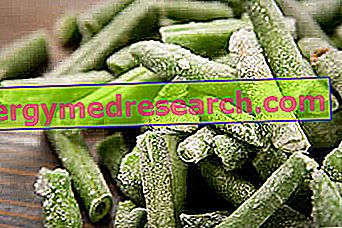Introduction
The idea of exploiting the protective action of low temperatures to prolong food preservation time was already bobbing in the minds of our ancient predecessors.

Freezing of food
The cold, like the rest of the heat, is a condition hostile to microbial life. While high temperatures lead to the almost total destruction of these microorganisms, the cold can only slow down its proliferation. When the cooling action is lost, the microbes begin to develop again, accelerating the decomposition processes of the food. To this bacteriostatic activity the cold also associates discrete bactericidal properties, especially when the low temperatures are maintained for a long time.
Obviously, the effectiveness of freezing is the greater the lower the temperatures reached by food. The lower the temperature, the greater the percentage of frozen water. By depriving the bacteria of this essential element for life, it is therefore possible to preserve food for a long time.
Freezing starts at temperatures between -0.5 and -2.8 ° C and, as these are lowered, affects a growing number of water molecules. However, a certain quantity, which varies from food to food, remains liquid even at temperatures of maximum freezing, due to its link with the constituents of the matter. The permanence of minimum quantities of water therefore allows a slow progression of the deterioration processes.
Rapid freezing
Freezing can take place more or less rapidly, causing different consequences on the chemical-physical integrity of the food.
- When the freezing process is too slow, the water forms ice macrocrystals that can damage the structure of the food, with consequent loss of nutritional principles and organoleptic characteristics. Because of this phenomenon, once thawed, foods appear watery and unappealing.
- In rapid freezing, small crystals are formed instead, which do not significantly alter the appearance, palatability and chemical-biological constitution of the food.
The slow freezing method was soon abandoned and today even domestic freezers are equipped with a button for rapid freezing, which allows a sudden drop in temperature, keeping it at around -30 ° C for as long as it takes to freeze food. .
Frozen or frozen
Freezing is a preservation technique based on rapid freezing. A food can be said to be frozen when it has precise quality requirements:
- it must have been frozen with an ultra-fast technique
- it must be ready for consumption
- it must be kept constantly at a temperature not exceeding -18 ° C
- it must be kept in a hermetically sealed package, from origin to sale
Freeze food
Domestic freezers are generally set at a temperature of -18 ° C which, as we have seen, is sufficient to optimally preserve the industrially frozen product. However, these values are not sufficient for a good freezing of fresh food.
Optimal freezing in a domestic environment must therefore rely on the rapid freezing method, integrated in most of the freezers. The key that activates this function must be kept active in the six hours preceding the introduction of the foods to be frozen, carefully stored in safe packaging. In any case, it is advisable to read the instructions in the instruction manual carefully, as the characteristics of the freezers vary from model to model.
General classification of the various compartments:
| * | temperature equal to or less than -6 ° C | Consume food within a week |
| ** | temperature equal to or less than -12 ° C | Consume them preferably within 15-20 days |
*** **** | temperature equal to or less than -18 ° C | Consume them preferably within the minimum conservation period |
CONTINUE: Duration of storage of frozen food »
Freeze food »



